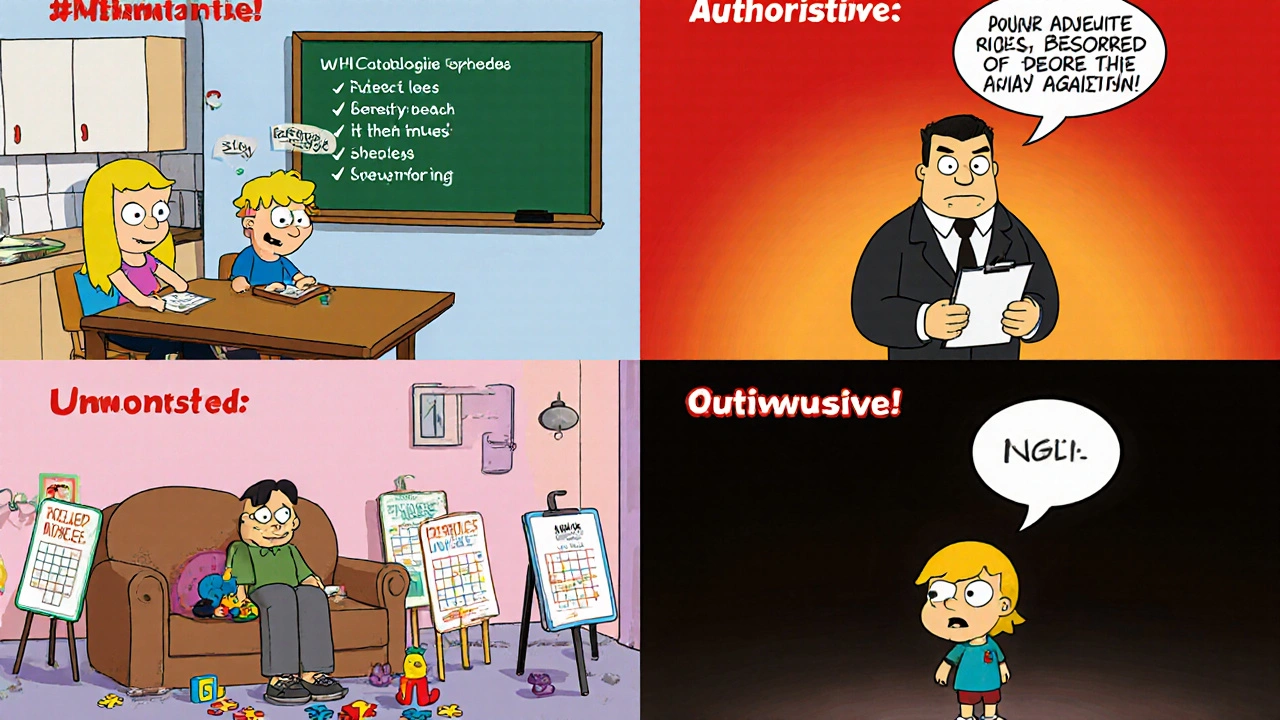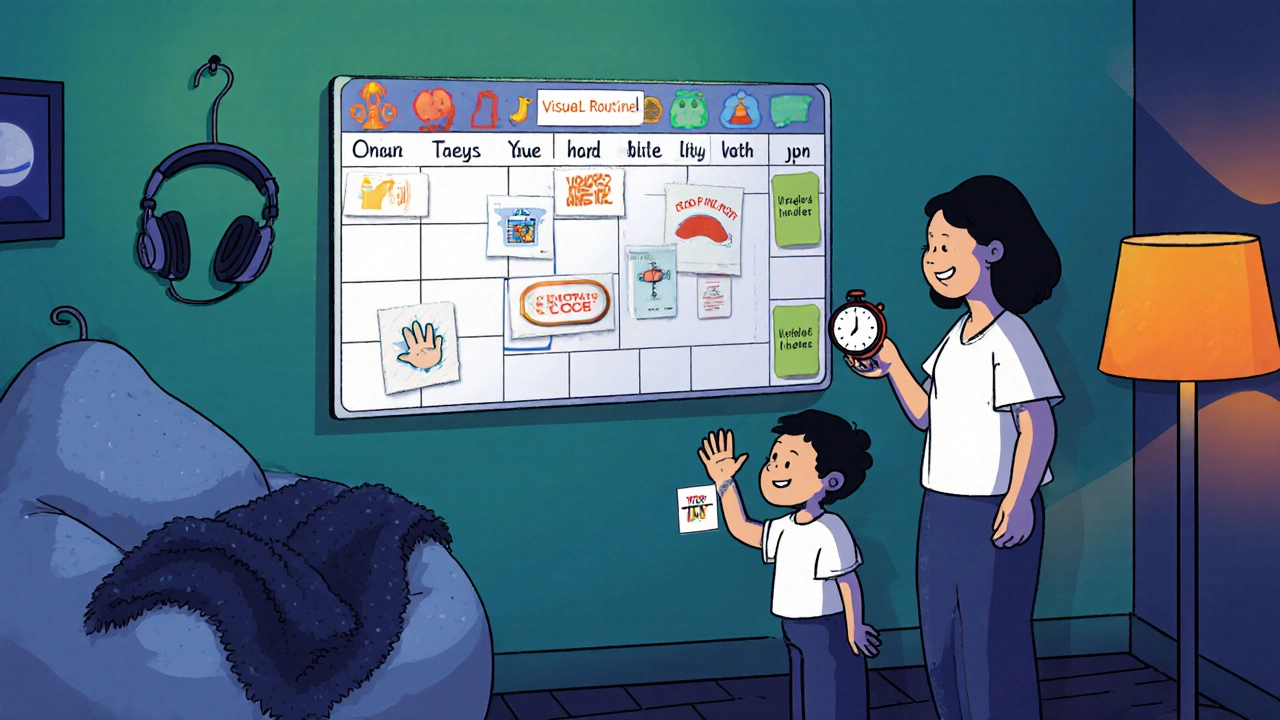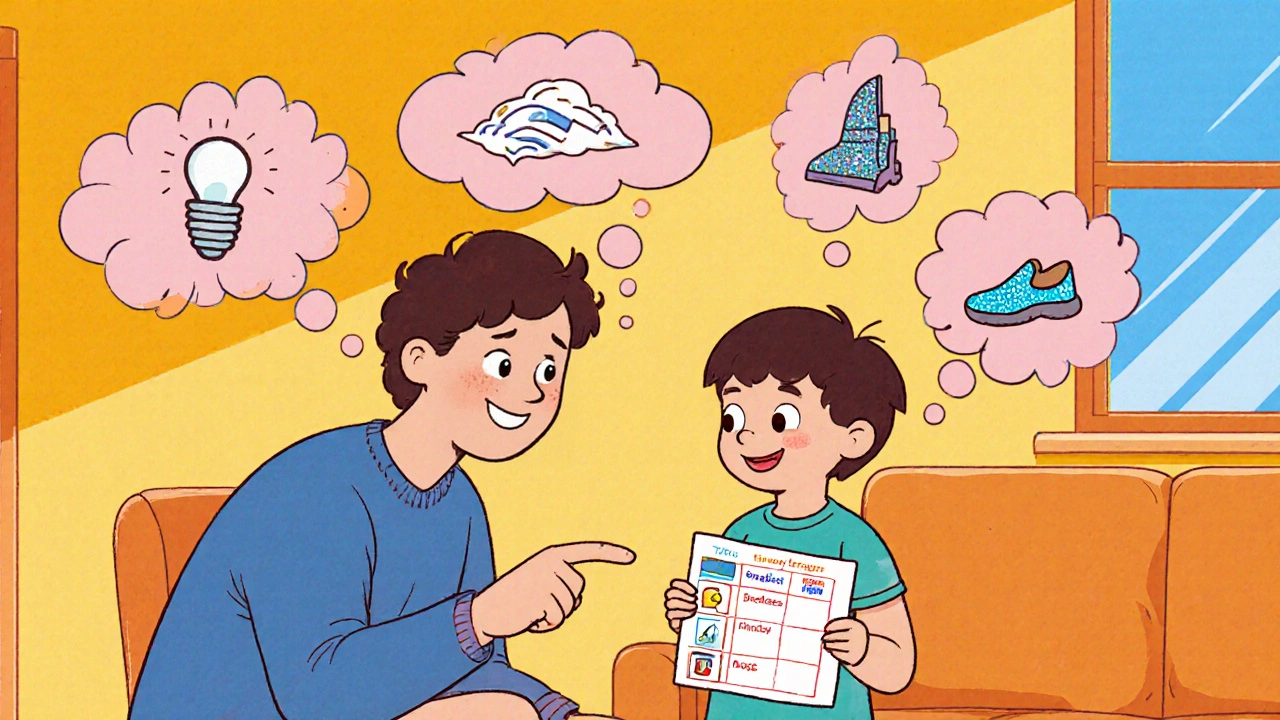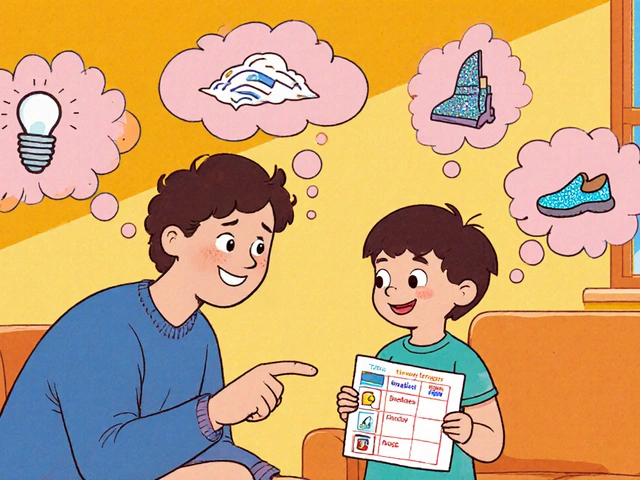Autism Parenting Style Compatibility Calculator
This tool helps identify which parenting style (authoritative, authoritarian, permissive, or uninvolved) may best support your autistic child based on their sensory needs, communication preferences, and your family's dynamics.
Your Results
Compatible StyleQuick Takeaways
- Know the core traits of Autism and how they shape daily life.
- Identify the four main parenting styles and see which aligns best with an autistic child's needs.
- Use the comparison table to spot strengths and blind spots of each style.
- Apply three practical adjustments-structure, sensory support, and collaborative communication-to any style you favor.
- Watch for common pitfalls like over‑control, under‑stimulation, and inconsistent routines.
Raising a child on the autism spectrum can feel like stepping into uncharted territory. Every parent wants to give their child the best chance to thrive, yet the usual parenting manuals rarely address neurodiversity head‑on. This guide breaks down how the most common parenting styles interact with autism and gives you a toolbox of concrete tweaks you can make today. By the end, you’ll have a clearer picture of which approach feels natural for your family and how to fine‑tune it for long‑term success.
autism parenting is a phrase that pops up a lot in searches, and for good reason: the blend of child‑specific needs and family dynamics is uniquely challenging. Below we start with a brief definition of the central concepts.
Autism is a neurodevelopmental condition characterized by differences in social communication, repetitive behaviors, and sensory processing. It affects about 1 in 100 children in the UK, with a wide spectrum of strengths and challenges that can shift daily.
Parenting Styles describe the overall attitude and strategies parents use to raise their children. Psychologists typically group them into four categories-authoritative, authoritarian, permissive, and uninvolved-each varying in warmth, structure, and control.
Understanding Autism Beyond the Checklist
Most resources list traits like "avoids eye contact" or "prefers routines," but a deeper look shows three interconnected pillars:
- Social Communication: interpreting facial cues, tone, and reciprocal conversation.
- Restrictive/Repetitive Behaviors: strong interests, need for predictability, and sensory sensitivities.
- Executive Function Challenges: planning, switching tasks, and regulating emotions.
These pillars influence how a child reacts to parental guidance. For example, a child who finds fluorescent lighting overwhelming may shut down when asked to join a noisy group activity, even if the request is delivered with love.
Four Parenting Styles at a Glance
Here’s a quick refresher on each style before we layer autism into the mix.
- Authoritative: High warmth, high expectations. Parents set clear rules but explain the why and invite input.
- Authoritarian: Low warmth, high expectations. Rules are strict, and questioning is discouraged.
- Permissive: High warmth, low expectations. Parents are indulgent and avoid setting boundaries.
- Uninvolved: Low warmth, low expectations. Minimal guidance or interaction.
Each style has research‑backed pros and cons for neurotypical children, but autism adds extra layers that can tip the balance.

How Autism Interacts with Each Parenting Style
Below is a side‑by‑side comparison that highlights where each style typically succeeds or struggles when applied to an autistic child.
| Style | Strengths for Autistic Children | Potential Pitfalls | Best‑Fit Scenarios |
|---|---|---|---|
| Authoritative | Provides structure while valuing the child’s perspective; encourages skill‑building. | May need extra time to explain abstract reasons; risk of overwhelming detail. | Families comfortable with open dialogue and consistent routines. |
| Authoritarian | Clear, unambiguous expectations can be reassuring for some children. | Low emotional support can increase anxiety; limited chance for child’s voice. | Situations requiring immediate compliance (e.g., safety protocols). |
| Permissive | High emotional warmth reduces stress; allows child‑led exploration. | Lack of routine may trigger meltdowns; difficulty learning self‑regulation. | When the child already has strong internal routine, but needs emotional validation. |
| Uninvolved | Very little pressure; child can develop independent coping mechanisms. | Absence of guidance often leads to missed developmental milestones. | Rarely recommended; only in contexts where external support (e.g., specialist services) is robust. |
Practical Adjustments You Can Add to Any Style
Regardless of your natural inclination, three evidence‑based tweaks make a big difference.
- Structure with Flexibility: Use visual schedules (icons, timers) to show what’s coming next, but include a “flex slot” for spontaneous interests. This blends the predictability many autistic children crave with the autonomy parents value.
- Sensory‑First Planning: Conduct a quick sensory audit of the home (lighting, noise, textures). If a child reacts to bright lights, add a dimmer switch or a pair of tinted glasses. Small changes reduce daily overload.
- Collaborative Communication: Teach the child a simple “stop‑and‑talk” cue (e.g., raising a hand) so they can signal when a request feels too much. Parents then pause, clarify, and adjust the demand.
These steps can be layered onto an authoritarian framework to soften harshness, added to permissive parenting to create needed boundaries, or used by authoritative families to fine‑tune their approach.
Building Family Routines that Support Neurodiversity
Routines are the backbone of a calm household. Here’s a template you can adapt:
- Morning Predictability: 5‑minute visual cue for each step-brush teeth, get dressed, breakfast. Include a “choice card” (e.g., two shirt options) to foster decision‑making.
- Mid‑Day Calm‑Down Zone: A designated corner with weighted blankets, noise‑cancelling headphones, and a timer. Use it when sensory overload builds.
- Evening Review: Spend 10 minutes reviewing the day with a picture board. Highlight successes (e.g., “You used the hand signal”) and note any triggers for tomorrow.
Embedding these checkpoints respects the child’s need for order while also teaching self‑advocacy-key goals for any parenting style.

Common Pitfalls and How to Dodge Them
Even savvy parents slip into habits that unintentionally stress an autistic child.
- Over‑Controlling: Micromanaging every interaction can stifle independence. Counteract by delegating a simple daily decision (e.g., snack choice).
- Under‑Stimulation: A permissive approach that avoids setting limits may leave the child without clear boundaries, leading to anxiety. Introduce one rule at a time and celebrate compliance.
- Inconsistent Routines: Switching bedtime by an hour on weekends throws off circadian rhythms. Keep core activities (sleep, meals) within a 30‑minute window daily.
Recognizing these patterns early helps you pivot before they become entrenched habits.
Next Steps: Resources and Support Networks
Putting theory into practice works best with external help. Consider these options:
- Local Autism Partnerships: Manchester Autism Support Group offers monthly workshops on sensory-friendly home design.
- Professional Coaching: An Applied Behavior Analysis (ABA) therapist can tailor behavior plans that align with your parenting style.
- Online Communities: Reddit’s r/AutismParents and Facebook’s “UK Autism Parents” provide peer‑to‑peer advice.
Pick one resource that feels reachable this week and set a small, measurable goal-like joining a forum thread or scheduling a home‑audit with a therapist.
Frequently Asked Questions
Can an authoritarian parent become more supportive for an autistic child?
Yes. Adding brief explanations for rules, allowing the child a choice when possible, and incorporating sensory breaks can soften the harsh edges while keeping clear expectations.
How do I know which parenting style I already use?
Reflect on three questions: Do I set rules? How warmly do I enforce them? Do I invite my child’s input? High warmth + clear rules point to authoritative; low warmth + strict rules indicate authoritarian, and so on.
What’s the best way to introduce visual schedules?
Start with a single daily routine-like bedtime. Use pictures for each step, place the board at eye level, and run through it together each night for a week before expanding.
Are there risks to using ABA with an authoritarian approach?
If ABA is applied without considering the child’s autonomy, it can feel punitive. Pair ABA with collaborative goal‑setting and celebrate small successes to keep it motivational.
How can I help my teen with executive function challenges?
Break tasks into micro‑steps, use digital checklists with reminders, and practice “planning pauses” where the teen reviews the upcoming activity before starting.







Wyatt Schwindt
October 17, 2025 AT 20:04Finding the right balance of structure and flexibility is key for autistic kids.
Lyle Mills
October 18, 2025 AT 04:24Deploying visual timetables taps into procedural encoding and mitigates executive dysfunction. Coupling sensory profiling with data‑driven ABA protocols yields measurable compliance improvements.
Barbara Grzegorzewska
October 18, 2025 AT 12:44Oh dear, let me enlighten you on the art of parenting autism-it's practically a symphony of neurodiverse crescendoes and quiet interludes. One must waltz between authoritarian rigor and permissive lullabies, lest the child drown in sensory cacophony. The tabla of routine beats must be tuned with a dash of spontaneous jazz, otherwise the whole house becomes a bland monotone. I’ve seen families who treat visual schedules like sacred scrolls, and trust me, that reverence is nothing short of legendary. So, dear reader, embrace the chaos, sprinkle in structure, and watch your little prodigy flourish like a phoenix amidst the mundane.
Nis Hansen
October 18, 2025 AT 21:04Parenting an autistic child invites us to contemplate the very nature of freedom and constraint. When we impose rigid hierarchies we risk silencing the child's authentic voice, a voice that often whispers in sensory subtleties. Conversely, an absence of structure can leave the mind adrift, untethered from the anchors of predictability it craves. The authoritative style, with its blend of warmth and clear expectations, mirrors the ancient Greek ideal of the just ruler guiding the polis. Yet even this noble approach must be tempered with the humility to listen to the child's internal geometry of comfort. Visual schedules serve not merely as calendars but as philosophical maps that translate temporal flow into concrete symbols. By externalizing the invisible scaffolding of routine we grant the child agency over their own narrative. Sensory audits, meanwhile, function as phenomenological experiments, revealing how light, sound, and texture shape perception. When parents adjust lighting or offer weighted blankets they are, in effect, co‑creating a shared phenomenology. The collaborative communication cue-a raised hand or simple token-operates as a contract between self‑advocacy and parental guidance. This contract reminds us that autonomy is not a zero‑sum game but a gradient where responsibility and freedom intertwine. In the context of executive function challenges, breaking tasks into micro‑steps mirrors the Stoic practice of focusing on the present action. Each micro‑step becomes a moment of mindful engagement, reducing the overwhelming horizon that looms for many autistic youths. Ultimately, the most effective parenting style is not a static label but an evolving dialectic, responsive to the child's shifting needs. By remaining curious, compassionate, and philosophically grounded, parents can nurture a garden where neurodiversity blossoms in full, vibrant splendor.
Fabian Märkl
October 19, 2025 AT 05:24Great rundown! 🎉 Adding a visual schedule can be a game‑changer for both kids and parents. Keep experimenting and celebrate every small win! 👍
Avril Harrison
October 19, 2025 AT 13:44Solid advice, especially the bit about sensory‑first planning-my sister’s kid swears by tinted glasses. It’s all about finding what clicks in your own household.
Natala Storczyk
October 19, 2025 AT 22:04THIS GUIDE IS A LIFESAVER!!! The way it blends structure with freedom is just *mind‑blowing*!!! I’m practically shouting from the rooftops about the sensory audit tip-don’t miss it!!!
nitish sharma
October 20, 2025 AT 06:24Dear parents, I commend your dedication to integrating evidence‑based strategies within your familial framework. Conducting a comprehensive sensory audit followed by incremental implementation will likely yield substantial improvements in adaptive functioning. I encourage you to schedule a consultation with a qualified specialist to tailor these recommendations to your child’s unique profile.
Rohit Sridhar
October 20, 2025 AT 14:44What an insightful post! I love how it breaks down the styles-makes it easy to pick what fits. Remember, you can start small; a single visual cue at breakfast can set the tone for the whole day. Celebrate each victory, no matter how tiny, because those moments add up to big progress over time. Keep experimenting, stay patient, and trust that your effort is shaping a brighter future for your child.
Sarah Hanson
October 20, 2025 AT 23:04Thank you for the thorough guide; it definitely covers the key aspects. I’ll be sure to incorporate the visual schedule tip into our routine.